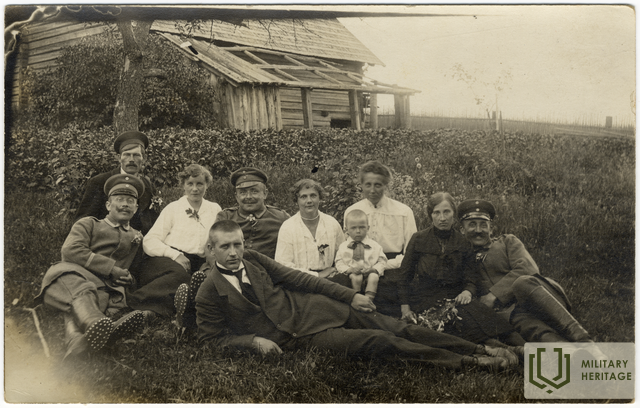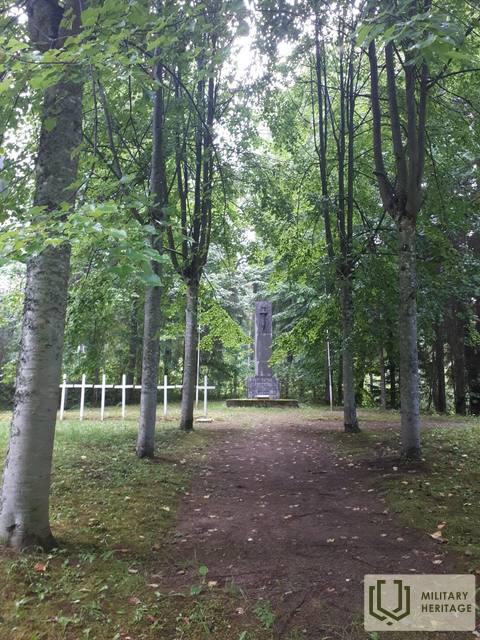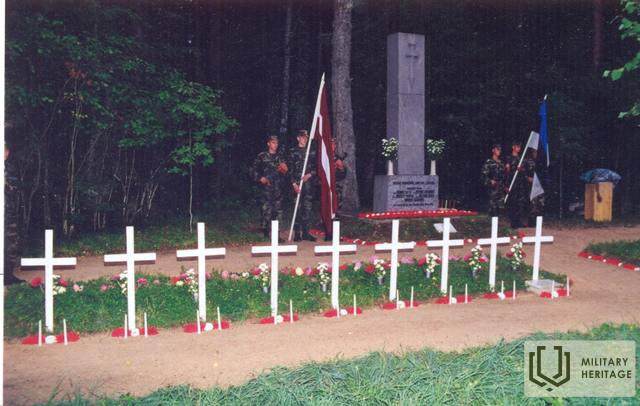Karvos brolių kapinės Memorialinė vieta

Įsikūręs Alūksnės–Apės kelio pakraštyje, netoli Zuši mājas, į pietus nuo Karvos, ties posūkiu į Rezaką.
Paminklas atidengtas 1937 m. rugsėjo 12 d. Granito stela buvo pagaminta O. Dambekalno akmens karjere Rygoje pagal Karo statybos valdybos architekto Vemerso Vitando projektą.
1975 m. rudenį vietos komunistai paminklą sunaikino. 1989 m. kovo 30 d. Alūksnės rajono taryba priėmė sprendimą paminklą restauruoti, o 1989 m. balandžio 30 d. jo vietoje buvo įrengtas laikinas medinis paminklas – latviško antkapio formos, kurį pagamino Valstybinės elektros gamyklos (VEF) darbininkas Jānis Jaunzemsas. Ant jo buvo užrašas: „Čia bus restauruotas Karvos brolių kapinių paminklas“.
Tuo metu buvo sutvarkytos ir netoliese esančios Brolių kapinės.
1993 m. Alūksnės brolių kapinių komiteto vadovo Uldos Veldre iniciatyva buvo atnaujinti memorialinės vietos restauravimo darbai. Naująjį paminklą pagamino Cėsių akmentašiai broliai Aivaras, Austris ir Auseklis Kerliniai.
Paminklas buvo atidengtas 1994 m. birželio 11 d.
Broliškose kapinėse palaidoti keturi Valmieros pėstininkų pulko 5-osios kuopos kariai - Jēkabs Sukse, Pēteris Leitlands, Ernests Puķītis ir Gustavs Ozols, žuvę mūšiuose prie Zušių 1919 m. balandžio 2 d. Penktasis kareivis, palaidotas XX a. 4-ojo dešimtmečio viduryje, buvo Roberts Glazners, Valmieros pulko karys, dingęs be žinios 1919 m. kovo 31 d. netoli Jaunosios muižos. Iš pradžių jis buvo palaidotas kaip nežinomas, tačiau vėliau jo vardas buvo patikslintas ir iškaltas paminkle. Savo ruožtu penktasis Zušių mūšyje žuvęs karys Augusts Dzedons (Ziedons) palaidotas Apekalnos kapinėse.
Prie paminklo papėdėje įrengta atminimo lenta Ungurių mūšio dalyviui Janiui Goldesui (1891–1952), žuvusiam komunistų koncentracijos stovykloje Intoje, Komijoje.
Antroji atminimo lenta, atidengta 1992 m. rugpjūčio 23 d., yra įrengta prie vieno iš medinių kryžių ir skirta 7-ojo Siguldos pėstininkų pulko kapralui Pēteriui Jansonui, kurį 1941 m. liepos 7 d. nužudė pasitraukiantys komunistai.
Panaudoti šaltiniai ir literatūra:
Lismanis, J. 1915–1920. Mūšių ir žuvusių kareivių atminimui: Pirmojo pasaulinio karo ir Latvijos išsivadavimo kovų memorialinės vietos. Ryga 1999, p. 18.
Alūksnės istorija. XIX a. pabaiga – 1920 m. sausio 2 d. Alūksnės muziejaus tyrimų medžiaga. Nr. 4-13.
Latvijos išsivadavimo karo istorija. Redagavo: Peniķis, M. T. 1, Ryga: Literatūra, 1938. P. 156–178.
Valmieros pėstininkų pulko istorija 1919–1929 m. Ryga: Valters ir Rapa, 1929. p. 20–67.
Susijusi laiko juosta
Susijusios temos
Susijusi istorija
Anšlavo Eglīčio prisiminimai apie Latvijos nepriklausomybės karą ir 1919 m. įvykius Alūksnėje
1919 m. kovo 27 d. 1-asis Valmieros pėstininkų pulkas kartu su Talino (tuometinio Rėvelės) ir Tērbato Estijos gvardijos (kaitselit) batalionais bei trimis šarvuočiais traukiniais pradėjo Latvijos išlaisvinimą nuo bolševikų nuo Melnupės upės krantų.














